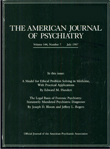Dispositional Predictors of Problem Gambling in Male Adolescents
Abstract
OBJECTIVE: This study investigated the possible relationship between impulsivity in early adolescence and gambler status in late adolescence. METHOD: Impulsivity measures consisting of self-reports and teacher ratings were gathered from 754 boys in early adolescence, and their gambling status in late adolescence was assessed with a self-report measure. RESULTS: On both measures of impulsivity, nongamblers had the lowest scores, recreational gamblers had the next higher scores, low problem gamblers had still higher scores, and high problem gamblers had the highest scores. CONCLUSIONS: These findings support the DSM-IV classification of problem gambling as a deficit in impulse control. (Am J Psychiatry 1997; 154:1769–1770)



